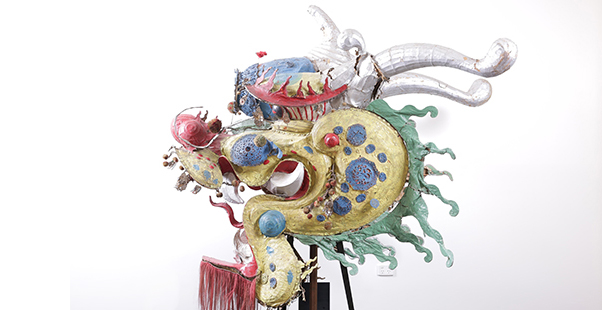 A new exhibition at Sovereign Hill’s Gold Museum has unveiled one of the most extensive Chinese artefact collections, and for the first time in over five decades, has reawakened Loong – one of Australia’s oldest dragons. On display until April 2018, Re-awakening the Dragon will showcase items once used by Ballarat’s Chinese community for social, cultural and religious ceremonies, including the spectacular dragon.
A new exhibition at Sovereign Hill’s Gold Museum has unveiled one of the most extensive Chinese artefact collections, and for the first time in over five decades, has reawakened Loong – one of Australia’s oldest dragons. On display until April 2018, Re-awakening the Dragon will showcase items once used by Ballarat’s Chinese community for social, cultural and religious ceremonies, including the spectacular dragon.
In 1897, Queen Victoria marked her sixty-year reign over the British Commonwealth, and celebrations were held throughout the colonies on Diamond Jubilee Day on 22 June, 1897. Ballarat’s Chinese community joined the festivities by staging an elaborate procession featuring colourful costumes, dragons, lions, exquisite silk textiles, banners and other regalia. Money was raised to purchase a collection of materials and textiles for the occasion from Canton, China.
The dragon and lion are the oldest documented examples in Australia, and Ballarat is now only one of four known sites where a Qing Dynasty dragon survives in whole or part. The Gold Museum’s dragon can be dated back to the late Qing dynasty (1644-1911).
“While Bendigo’s Loong, one of the four surviving dragons is well-known, our dragon will be unveiled for the first time in many years,” says Jeremy Johnson, CEO Sovereign Hill. “In every museum, there’s never enough space to display everything in a collection, and that’s why this exhibition is so special.”
“These treasures, and the spectacular dragon, have been in the Gold Museum’s collection stores for many years, and will showcase the important role Chinese people, and their processional ceremonies, played to the town of Ballarat and the goldfields.”
In 1962, Ballarat’s most prominent Chinese temple, on Main Road, was closed, and while some temple artefacts fell into private hands, the bulk was donated to the Ballarat Historical Society. The donation included rare carvings, altar-pieces and processional material such as textiles and a dragon and lion dating back to the late 19th century.
The collection was transferred to the Gold Museum in the 1970s and 1980s, and has remained in the Gold Museum’s collection stores ever since. Re-Awakening the Dragon showcases this extensive collection for the first time.
Highlights of the exhibition include:
- Dragon Head, circa 1897: Loong is made from layers of papier-mâché, kingfisher feathers, mirrors and pompoms. His face has been painted over, though the original layer is partially visible. Portions of the dragon’s body have survived including fragments of his scales and tail. His final appearance was at the Ballarat Begonia Festival in the 1960s.
- Flaming pearls, circa 1897: The flaming pearl and teaser are essential to a dragon procession. The pearl is frequently featured in Chinese art and represents wisdom and knowledge. A dragon is led in the dance by a man carrying a flaming pearl. He is usually accompanied by another person carrying a teaser or ‘dragon ball’.
- A collection of highly decorative processional silk costumes, including jackets, pants, headdress and skirts. Depending on one’s rank in the procession, some costumes were more elaborate than others.
- Warring States banner: The Warring States period (circa 475-221 BC) was marked by intense battles between the seven powerful states of China. It ended with the state of Qin seizing the remaining six states and establishing the first unified Chinese empire. The centre of this banner features the Chinese character Zhao, one of the seven states. The banner appeared on the 1901 arch for the Duke and Duchess of York, together with six other banners.
- Carved Temple Panel, 1868: The Chinese text on the panel reveals that it was presented to a local temple in 1868 by benefactor Mr Huang Jiangxia. The motto in large letters reads: ‘Endless Holy Grace’.
Considerable time and effort has been spent on caring for the museum’s Chinese processional and temple collections. Behind the scenes, the objects are kept in a climate controlled area, with smaller pieces housed in special acid-free boxes to keep them free from dust, pests and general damage. While on display, specific mounts, cases and stands have been created for delicate objects, such as Loong and the processional textiles, to protect them from further damage.
Basic conservation has been carried out to protect the objects, but further work is needed due to the fragile nature of the pieces. Intensive conservation is a highly skilled and expensive process. Therefore, the Gold Museum has launched the Awaken the Dragon Appeal to raise much-needed funds to carry out the next stage of the conservation process.
Visitors will get a chance to learn how these precious items are cared when, on occasion, the Gold Museum volunteers and staff will be on site in the gallery cleaning and re-housing items from the collection.
Re-Awakening the Dragon
Gold Museum, Bradshaw Street, Ballarat
Exhibition continues to 15 April 2018
Admission fees apply
For more information, visit: www.goldmuseum.com.au for details.
Image: Ballarat dragon (Loong), circa 1897 (supplied)
